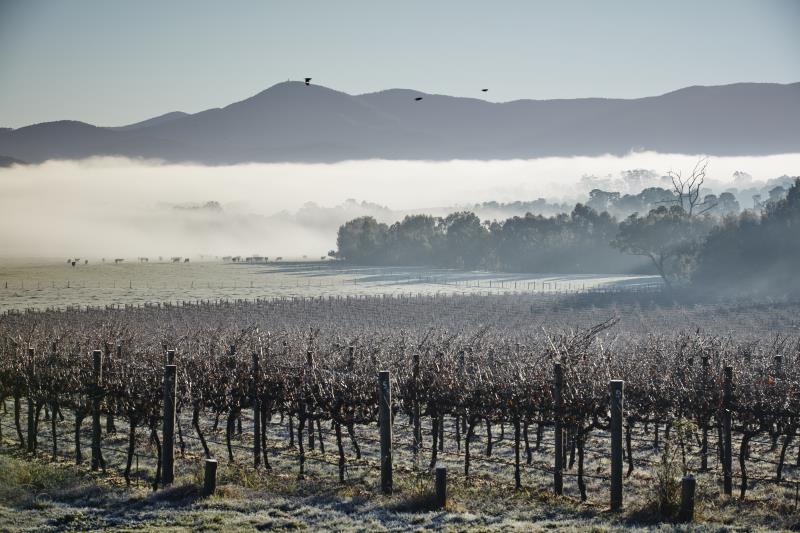Our Victoria wine region guide takes a look at the terroir essentials and gives you an in-depth presentation of the wine region, along with the fast facts, on Australia’s third highest-producing state. This region is a real powerhouse of innovation with its great diversity of terroirs, varieties and wine styles made by some 800 producers spread over its many sub-regions. Read on for the ultimate study guide to Victoria wine region and its sub-regions of Murray Darling, Swan Hill, Rutherglen, Glenrowan, Beechworth, King Valley, Alpine Valleys, Stathbogle Ranges, Upper Goulburn, Goulburn Valley, Heathcote, Bendigo, Pyrenees, Grampians, Macedon Ranges, Sunbury, Yarra Valley, Geelong, Mornington Peninsula and Henty.
Where is it?
This is a region in southern Australia close to the city of Melbourne.
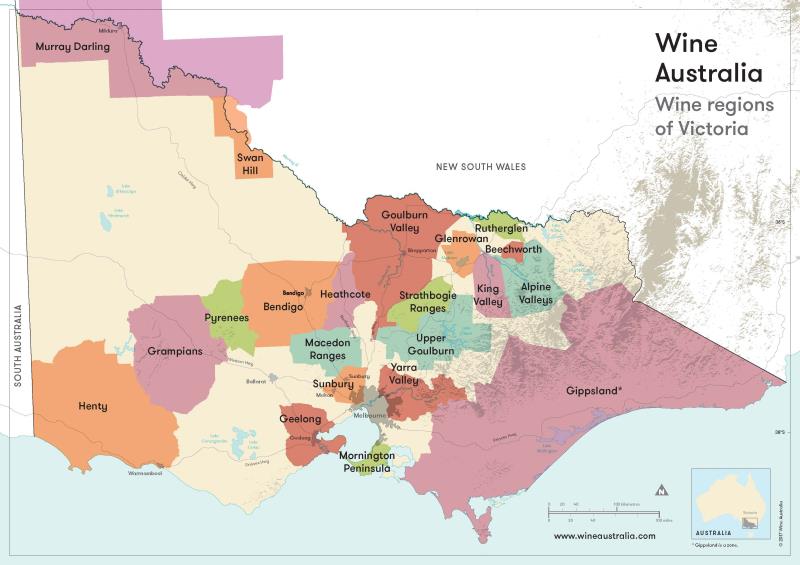
Wine regions of Victoria. Courtesy of Wine Australia
Latitude
Geelong: 38º S
Longitude
Geelong: 144º E
Altitude
Vineyard altitudes range between 20 and 1000 metres above sea level.
Main regions and appellations of Victoria
Victoria is extremely diverse, with 19 official wine zones, some divided into smaller sub-regions.
[mepr-hide if=”rule: 2080″]
…
This content is exclusive for Members. Take a look at the introductory packages below to become a Member of 80 Harvests and get unrestricted access to all our content.
This Victoria wine region guide includes details on:
- the climate of Victoria and its sub-regions
- the soils of each sub-region
- the main grape varieties and wine styles established in Victoria and upcoming new varieties and styles
- viticulture and vineyard management
- winemaking techniques in Victoria
- production statistics and key producers
… all in one place! It’s a great guide if you are studying wine or a wine enthusiast.
Thank you for supporting the journey and being part of the 80 Harvests community!
[mepr-group-price-boxes group_id=”2070″]
[/mepr-hide]
[mepr-show if=”rule: 2080″]
Murray Darling
Australia’s second largest wine-producing region, Murray Darling is such a large region that it covers a sizeable area in Victoria and protrudes into New South Wales. Together with Riverina and Riverland, Murray Darling forms part of the appellation South Eastern Australia and has a name for large-scale, efficient production of grapes for value-for-money wines. This is a hot area with little rainfall and low humidity, great for producing healthy grapes, so long as there is water for irrigation during the growing season. These areas follow the Murray river and used to have lots of water as a result, but recent droughts mean they have to be more water-efficient. The soils are calcareous and support high yields, which the high irrigation levels of the past also encouraged, hence the region’s reputation for large quantities of value wines. Chardonnay, Shiraz and Cabernet Sauvignon are the best-known wines from here but wine producers are now experimenting with different varieties and different wine-making techniques to produce some quite innovative wines.
Swan Hill
Situated on the Murray River, Swan Hill also enjoys a warm climate but is marginally cooler than Murray Darling and so budburst, flowering and harvest are all slightly later. It is known for deep-coloured, fruity Cabernet Sauvignon, as well as Chardonnay and Shiraz.

Morris Wines in Rutherglen. Photo credit: Ewen Bell Wine Australia
North-East Victoria
Warm areas: Rutherglen and Glenrowan
The climate in these areas is continental, with very hot summer days (mean January temperature of 22.3°C) and cold nights. The growing season can be threatened by the spring frosts, exacerbated by cold air blowing down from the mountains to the south, and the abrupt arrival of autumn rain.
Rutherglen and Glenrowan are both known for the fortified wines that were once hugely popular and both still produce world-class fortified aged whites to this day. However, both areas also produce big red wines, especially from Shiraz and Durif, as well as a wide range of other styles of wines, ranging from sparkling Shiraz, through whites, such as Riesling, Marsanne and Chardonnay and reds from Sangiovese and Gamay.
Higher and cooler areas:
King Valley
This 1,370-hectare premium region has vineyards planted at different elevations and with soil types, though mostly the soil is fertile, leading to good yields. The area was traditionally settled by farmers from Italy and more recently a number of Italian producers have invested in the region. In fact, its regional association presents King Valley as “Australia’s home of Italian wine styles”, so it’s no surprise that the two most planted varieties are Italian favourites Pinot Grigio and Glera (known here as Prosecco) and producers have been experimenting with Italian alternative varieties, such as Arneis, Verduzzo, Graciano, Marzemino, Mondeuse, Sagrantino and Saperavi. French varieties also feature, with Chardonnay, Sauvignon Blanc and Merlot being among the most planted and some plantings of Petit Manseng and Tannat. A wide range of wine styles are made here, including sparkling.
Alpine Valleys
The vineyards of Alpine Valleys are planted at altitudes ranging between 180 and 1972 metres above sea level, resulting in lower temperatures and slower ripening and hence wines with crisp acidity and fresh aromas and flavours. The five most planted varieties reflect this cooler climate: Sauvignon Blanc, Chardonnay, Pinot Grigio, Glera (Prosecco) and Pinot Noir. At lower altitudes, some full-bodied, earthy reds are made from Cabernet Sauvignon and Shiraz.
Beechworth
This is a small viticultural area (100 hectares), situated at a slightly lower altitude. Chardonnay, Pinot Noir and Shiraz are among the top plantings here but a number of alternative varieties have been planted too, including some Italian varieties.
Western Victoria
Grampians
An area spanning 518 hectares, situated at the western end of the Great Dividing Range. Vineyard altitudes vary greatly (from 142 to 1161 metres above sea level), making it difficult to generalize about climate. Shiraz is king here, accounting for 79% of production in 2017.
Well-known producers local producers Seppelt and Best’s have a reputation for making still and sparkling wine from here and they also bring in grapes from elsewhere, like Padthaway and Murray. Other varieties grown in this area include Riesling, Cabernet Sauvignon and Pinot Noir and Italian varieties Sangiovese, Pinot Grigio and Dolcetto.
Pyrenees
This is an area of rolling hills with varying elevations and aspects to the east of Grampians. It is known for its Cabernet Sauvignon and Shiraz but also produces some very good white and sparkling wines.
Henty
This is one of the coolest wine-producing areas on the Australian mainland, especially on the coast. It produces good whites, especially Riesling, some very exceptional Bordeaux-style Cabernet Sauvignon and cool-climate Shiraz.
Central Victoria
Bendigo
Based in central Victoria, this is an area with a Mediterranean climate with warm, dry summers and wet winters. The vineyards are planted at different elevations, so there are some areas producing cooler-climate varieties like Pinot Noir, but Bendigo is known for its red wines from Shiraz and particularly Cabernet Sauvignon, which tends to be deep in colour, high in tannins, with aromas that can range from herbaceous through to lush black fruit.
Heathcote
With mean January temperatures close to 22˚C and rising, Heathcote is another area where red wine stands out with red varieties accounting for 84% of all plantings in its 1,231 hectares. Here, Shiraz is king, responsible for 56% of total production in 2017. The soils are calcium-rich red Cambrian soils that drain and yet retain water so irrigation is usually not needed.
Goulburn Valley
An area of rising temperatures, tempered by varying elevations (up to 411 metres above sea level), Goulburn Valley has over 1000 hectares planted with vines. The soils tend to be free-draining and the Goulburn River and various lakes provide water for irrigation. This area is known for its Shiraz, Marsanne, Cabernet Sauvignon, Chardonnay, Riesling and Sauvignon Blanc.
Upper Goulburn
This is an area of higher altitudes (up to 800 metres) and is known for its white wines, including Chardonnay, Sauvignon Blanc and Riesling.
Strathbogie Ranges
This is a varied area that lies between Goulburn and Upper Goulburn. Vineyard elevations vary between 160 and 600 metres above sea level, so while to the north-west, some full-bodied reds are made from Cabernet Sauvignon and Shiraz, in the higher areas to the east, white varieties and Pinot Noir dominate. For instance, Domaine Chandon grows Pinot Noir and Chardonnay for its sparkling wines here. Chardonnay, Sauvignon Blanc and Riesling are among the other varieties produced in this area.
Port Phillip
This is the area clustered around Melbourne.
Sunbury
This is an area of windswept plain close to Melbourne at around 275 metres above sea level. The climate is cooled by the Macedon Ranges to the north and the ocean to the south, making for good quality, fruit-driven wines. Varieties include Shiraz, Cabernet Franc, Chardonnay, Riesling and some Italian varieties.
Macedon Ranges
At the southern end of the Great Dividing range with vineyards at elevations of 300 to 700 metres and poor soils, this is a decidedly cold area, known for producing good Chardonnay, Riesling and Pinot Noir, as well as Cabernet Sauvignon, especially for red blends. Sparkling wines are also made here.
Geelong
This windswept area is classed as having a cool climate because those vineyards close to the coast receive a marine influence from Port Philip Bay or Bass Strait, while the vineyards further north are at altitudes of up to 400 metres. The mean temperature in January is 19ºC. Rainfall averages 540mm and mostly falls in winter and spring. The constant winds help keep vines disease-free and the long, cool, dry autumn makes for healthy and ripe grapes.
Its 780 hectares are divided between three sub-regions: Surfcoast/Otways, Moorabool Valley and The Bellarine.
Geelong producers make Pinot Noir, Chardonnay, Shiraz, Sauvignon Blanc, Pinot Gris, Riesling, Cabernet Sauvignon and a number of other varieties.

Yabby Lake Vineyard, Mornington Peninsula. Photo credit: Ewen Bell Wine Australia
Mornington Peninsula
This is a peninsula near Melbourne, surrounded on three sides by water so there is a strong maritime influence. Prevailing winds blow in from the north-west over Port Phillip Bay and from the southeast of the Southern Ocean. Summers are mild with lots of sunshine and a mean temperature in January below 20˚C. Rain falls mainly in winter and spring.
Pinot Noir is the signature variety of Mornington Peninsula and accounts for half of its plantings, with Chardonnay responsible for a further 25%. Pinot Gris is the third most planted variety. There are over 200 growers in this region, with two-thirds of holdings being less than 4 hectares in size. Many make their own wine and cellar door sales and wine tourism are important.

Yarra Valley vineyard. Photo credit: Ewen Bell Wine Australia
Yarra Valley
One of Australia’s emblematic regions with 2150 hectares of vineyards planted in elevations where cool nights and warm days make for slow, consistent grape ripening. Around 750-950mm of rain, which falls mainly in winter and spring, so irrigation is needed in the summer. The summer tends to be cool and dry with a mean January temperature 18-19˚C.
The Yarra Valley’s key varieties are Pinot Noir, Chardonnay (made in a refined but sometimes austere style), Cabernet Sauvignon, Shiraz and Sauvignon Blanc.
Yarra was the first Australian location chosen by Domaine Chandon and is known for their bottle-fermented sparkling wines and also Green Point still wines.
Gippsland
The Gippsland wine region covers a large area extending from the border with New South Wales, hugging the coast to Wonthaggi near Melbourne, then west to the edge of the Great Dividing Range. Inland are rolling hills, so vineyards can have quite varied mesoclimates. Cabernet Sauvignon, Merlot, Pinot Noir and Chardonnay are major varieties here.
Climate in Victoria wine region
Victoria is a large and diverse wine-producing state with vineyards at different altitudes and some that are subject to at least some maritime influence, although this is less marked than in some countries in the world, as the sea temperatures are warmer. Summer is dry, autumn sets in early and winter and spring are mild and damp
Temperatures
Vineyards in areas close to the coast or at greater altitudes have a mean temperature in January slightly below 20˚C, while the mean January temperatures at lower altitudes can be 22˚C or 23˚C.
Rainfall
Rain mainly falls in winter and spring so irrigation is needed during the growing season in most regions. Annual rainfall can vary significantly between 540mm on average in Heathcote through to 1187mm in Alpine Valleys.
Climate change and drought
Climate change is being taken very seriously in Australia and Victoria is at the forefront in terms of experimentation with varieties of vines that will better cope with warmer, drier conditions, particularly those originating in warmer countries, such as Spain, Portugal and Italy.
Recent years have also seen significant times of drought, particularly for the warm inland areas like Murray Darling and its neighbouring regions of Riverland and Riverina, which irrigate using water from a large river basin supplied by snow runoff from the Snowy Mountains. However, during the last few decades, the water reserves have dropped hugely and irrigation has become financially unviable for some growers, leading to some vineyards being grubbed up.
Soil and topography
This varies enormously from area to area.
Grape varieties and wine styles in Victoria
The Australian Bureau of Statistics lists 20 red and 20 white varieties, plus “others” in its survey for 2015, confirming that Victoria is really experimenting with alternative varieties. There are a significant number of varieties originally from Italy among those being grown in this state.
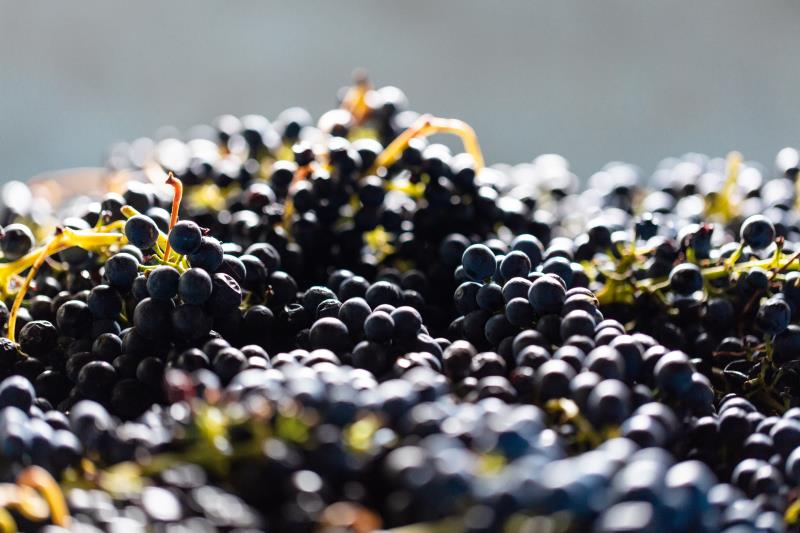
Shiraz grapes. Photo credit: Andre Castelluci Wine Australia
Red wines in Victoria
Shiraz (aka Syrah)
Shiraz is king in the Victoria wine region, with 5803 hectares planted (42% of the 13,650 hectares planted with black varieties).
Shiraz is grown in all types of terrain and at different elevations and the wine styles vary significantly depending on which Victoria wine region it is grown in. For instance, warm areas like Rutherglen and Glenrowan produce full-bodied, deep-coloured wines with a dark fruit profile and, similarly, Bendigo is known for its deep-coloured, mouth-filling and voluptuous Shiraz wines with notes of red berries and cherries, pepper and spice. Meanwhile, Shiraz from the distinctly cool Macedon Ranges has more upfront notes of pepper and spice, accompanied by liquorice and fresh red and black fruit.
Shiraz is a significant variety in Murray Darling and Swan Hill, where it is made into affordable, smooth, medium-bodied and fruity reds for early drinking.
Cabernet Sauvignon
This is the second most popular red variety in Victoria, accounting for 3000 hectares of vines. Like Shiraz, it is grown in both warm and cool-climate areas, making for different profiles in the finished wine. Furthermore, Cabernet Sauvignon from the different Victoria wine regions can be a single-variety wine or be part of a blend, either with Shiraz or other Bordeaux varieties like Merlot.
For instance, in the Yarra Valley, Cabernet Sauvignon is often blended with small amounts of Cabernet Franc and Merlot and the wines range from medium to full-bodied with silky tannins through to aromatic and floral with herbal characters. Meanwhile, Cabernet Sauvignon from the warm climate of Heathcote is rich and generous, with blackberry aromas and flavours.
Pinot Noir
Number three in terms of reds, there are 1990 hectares of Pinot Noir planted in Victoria, mostly in its cooler areas near the coast or at high altitudes. It is made into fresh, fruity red wines and sparkling wines. The red wines from areas like Strathbogie Ranges and Mornington Peninsula are typically an attractive ruby colour, feature red fruit aromas like strawberries and have fresh acidity and medium to light body and soft tannins. South Gippsland Pinot Noir is considered to be particularly fine, elegant, long and intense and potentially among Australia’s finest.
Merlot
Another favourite, Merlot accounts for 1658 hectares of vineyards across the Victoria wine region. This soft, plummy variety often finds its way into blends, for instance with Cabernet Sauvignon, bringing a soft roundness to complement the Cabernet’s unbending structure of high acidity and tannins.
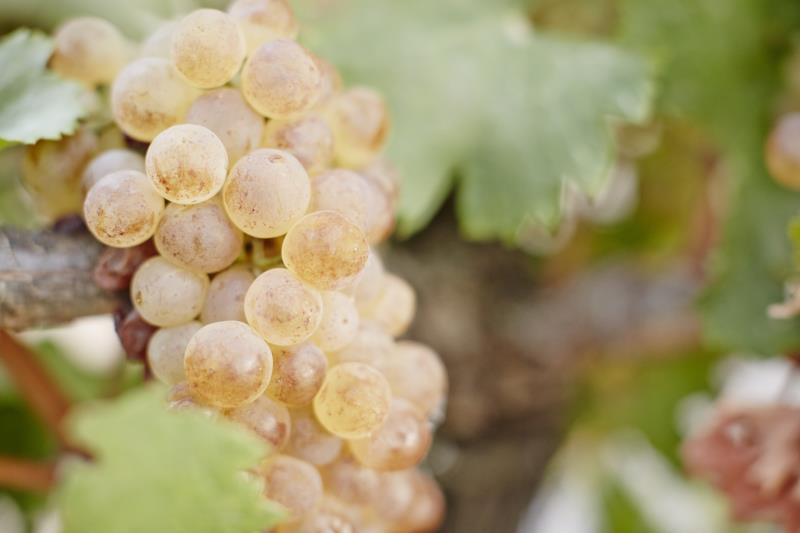
Photo credit: Ewen Bell Wine Australia
White wines
Chardonnay
Chardonnay is the second most planted variety after Shiraz and accounts for close to half of all white variety plantings, with 4478 hectares. Like Shiraz, it appears in many subregions and varies hugely in style.
Chardonnay from warmer, lower areas, like Beechworth, produce softer, fuller-bodied styles with white fruit aromas. Chardonnay is an important variety in Murray Darling and Swan Hill, where it is made into easy-drinking, good-value whites.
Meanwhile, Chardonnay grapes from higher altitude or coastal areas can make leaner, fresher styles with fresh acidity, although winemaking techniques such as use of oak for fermentation and/or maturation, partial or complete malolactic fermentation and the decision of whether or not to age the wine over its lees can make a huge difference on the final style.
Chardonnay is also grown for sparkling wines.
Sauvignon Blanc
With 1069 hectares across the state, this is number two in the whites and the only other white variety with very significant levels of plantings. It is mainly planted in cooler areas, like Strathbogie Ranges and Pyrenees, where it is made into lean, fresh styles with pronounced herbaceous and fruity aromas.
Riesling
Many of Victoria’s cooler-climate areas like Grampians and Macedon Ranges are proud of their Riesling. Lean and fresh, these wines have a characteristic lime juice aroma that with age mellows and evolves to more honeyed notes, sometimes alongside a whiff of kerosene.
The slightly warmer Goulburn Valley also makes a fuller-bodied Riesling with lime and tropical fruit aromas and flavours and the capacity to age over the medium term.
Pinot Gris
Another popular white variety, Pinot Gris is one of the key wines made in Mornington Peninsula, where it can be medium-bodied with stony, mineral notes and vibrant fruit. In King Valley, it is made into both the fuller-bodied, French Pinot Gris style with tropical fruit and high acidity and the lighter Italian Pinot Grigio style, with citrus and pear aromas and a crisp finish.
Alternative varieties in the Victoria wine region
Right across Victoria’s wine regions, producers are experimenting with alternative varieties, many originally from warm-climate areas of Europe, like Spain, Portugal, and especially Italy. The following are just some of the alternative wine varieties now being made in this state: Arneis, Glera (known here as Prosecco), Verduzzo, Graciano, Marzemino, Mondeuse, Sagrantino, Dolcetto, Saperavi, Petit Manseng and Tannat.

Photo credit: Ewen Bell Wine Australia
Sparkling wines
Sparkling Shiraz
Sparkling Shiraz, or “sparkling Burgundy” as it was known, has been made in Victoria since the 1890s and it is a quintessentially Australian style of wine. These days sparkling red wines are sometimes also made from other varieties like Cabernet Sauvignon and Merlot, but it is Shiraz that is most famous.
Winemakers select elegant, aromatic grapes and make the base wine in the usual manner for still red wines. The second fermentation to make the wine sparkle can occur by carbonation, tank fermentation, transfer or in-bottle fermentation. Some producers keep the still red wine in stainless steel tanks until they need it, then they put it through the second fermentation. These wines may, in fact, be a few years old but still seem young and fresh.
Sparkling Shiraz wines are very dark-coloured, have significant levels of tannin and body and the aromas of the variety, which may or may not be augmented by oak-influenced aromas and flavours. Many sparkling Shiraz wines are also rather sweet, with 20-40 grams of sugar per litre of wine. They take a little getting used to but are ideal for a barbecue on a hot day.
Traditional method sparkling
Back in the 1980s, Champagne producers Moët & Chandon chose the Yarra Valley as their base for their Australian venture, Domaine Chandon. Here they produce outstanding sparkling wines from Pinot Noir and Chardonnay sourced from several cool-climate regions in Victoria, using the traditional, in-bottle fermentation method.
Other wine producers across the Victoria wine region have followed suit, using grapes grown in cool-climate areas like Macedon Ranges and the King Valley.
Tank method sparkling
Many of the sparkling wines on sale in Australia are made by fermenting the base wine in a special tank that retains the carbon dioxide that is released during the fermentation, making the wine fizzy. These wines can be made with the classic Champagne varieties Chardonnay and/or Pinot Noir or a whole range of other grapes.
Producers in the King Valley have pioneered Australia’s answer to Prosecco, made with Glera (known here as Prosecco), the same grape as the Italian tank-method fizz. These are light, easy-drinking dry sparkling wines with fruity aromas.
Pét-nats (pétillant naturel)
The latest trend in Australia, these are sparkling wines made using the méthode ancestrale, where the wine is usually bottled before the primary fermentation is finished, without the addition of any secondary yeasts or sugars. The wine can be made from any grape variety that is high in acidity, like Sauvignon Blanc or Riesling and can be dry or sweet. Usually they are lightly sparkling and they can be slightly cloudy because of being unfiltered. South Australia is leading the way with this style, but there are a number of producers in Victoria too.
Fortified wines
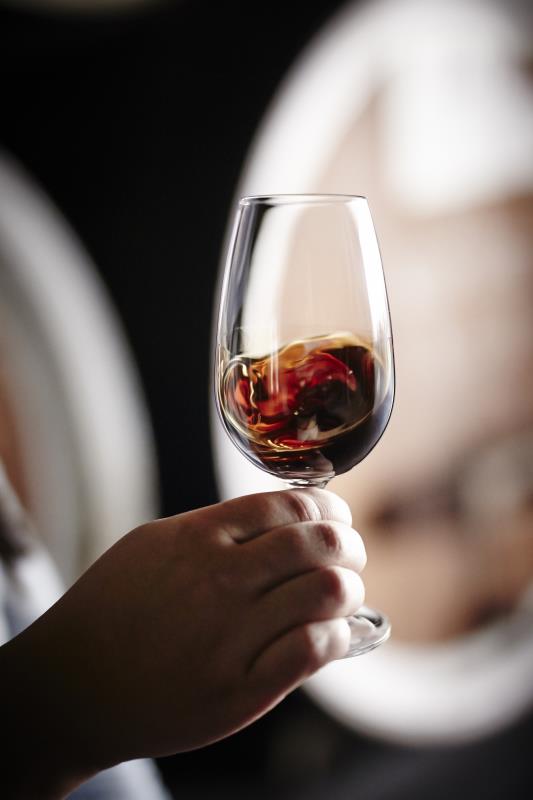
Fortified wine at Morris Wines. Photo credit: Ewen Bell Wine Australia
Rutherglen Muscat
This is a style of wine made famous by (and almost exclusive to) Rutherglen and its neighbour Glenrowan and so deserves special mention. Produced from the brown clone of Muscat à Petits Grains Rouge, more commonly known as Rutherglen Brown Muscat or Brown Frontignac, this is Rutherglen’s most famous fortified wine variety and it is considered to be one of the great sweet wines of the world.
The fruit is allowed to hang on the vine for longer, accumulating extra sugar. The harvested fruit is pressed and the must begins fermentation, which is stopped after a few days by the addition of natural grape spirit. The sweet fortified wine is then aged in warm conditions in oak barrels, often in a modified solera system where it is transferred from barrel to barrel over a period of years, becoming progressively darker in colour and more complex in aromas and sticky.
Very rich and sweet, these wines have lots of dried fruit aromas and flavours – like a really rich Christmas pudding in liquid form. Delicious with a pudding or after dinner.
Rutherglen Muscats are classified as follows.
- Rutherglen Muscat – this is the youngest with an average age of 3-5 years and has fresh raisin aromas, rich fruit, clean spirit and great length. Residual sweetness is 180-240 grams per litre.
- Classic Rutherglen Muscat – this is an average age of 6-10 years and is more rich and complex, produced through the blending of selected plots of wine, often matured in various sizes of oak cask to add complexity. Residual sweetness 200-280 grams per litre.
- Grand Rutherglen Muscat – takes the flavour of Rutherglen Muscat to a still higher plane of development, displaying a new level of intensity, depth and concentration of flavour, mature rancio characters, and a complexity which imparts layers of texture and flavour. Average age 11-19 years. Residual sweetness 270-400 grams per litre.
- Rare Rutherglen Muscat – these wines tend to be at least 20 years old and are very complex and evolved. They are made by blending the very best wines and are bottled in small quantities and so difficult to get hold of. Residual sweetness is a very sticky 270-400 grams per litre.
Viticulture facts and vineyard management in the Victoria wine region
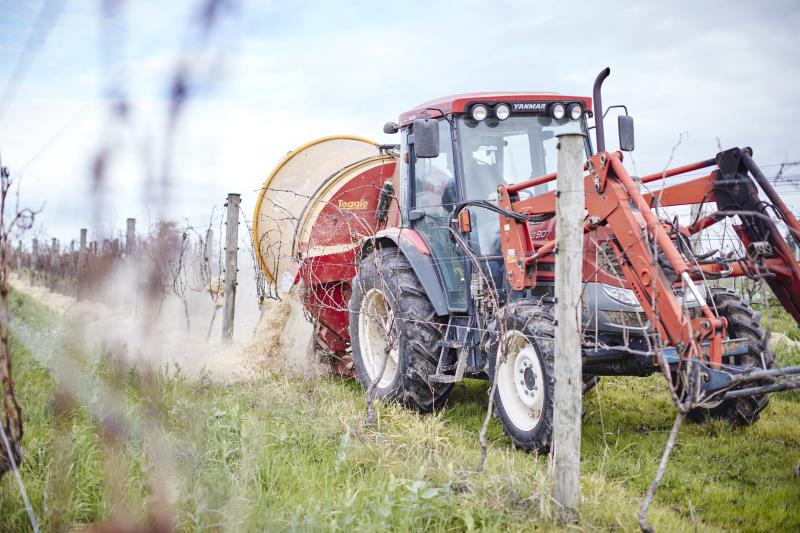
Photo credit: Ewen Bell Wine Australia
Planting density and vine training systems
Australia’s vineyards tend to be highly mechanized with 80% of the grapes being machine-harvested and many other vineyard tasks performed by machine. Therefore planting densities and training systems are firstly designed to enable machinery to pass along rows, with canopies and clusters of grapes uniformly organized for ease of work.
Australia has been at the forefront of research into training systems and canopy management techniques and producers use those that work best for their varieties, terrain and climate.
Irrigation
This is a must in most wine regions across Victoria and water availability is becoming an issue.
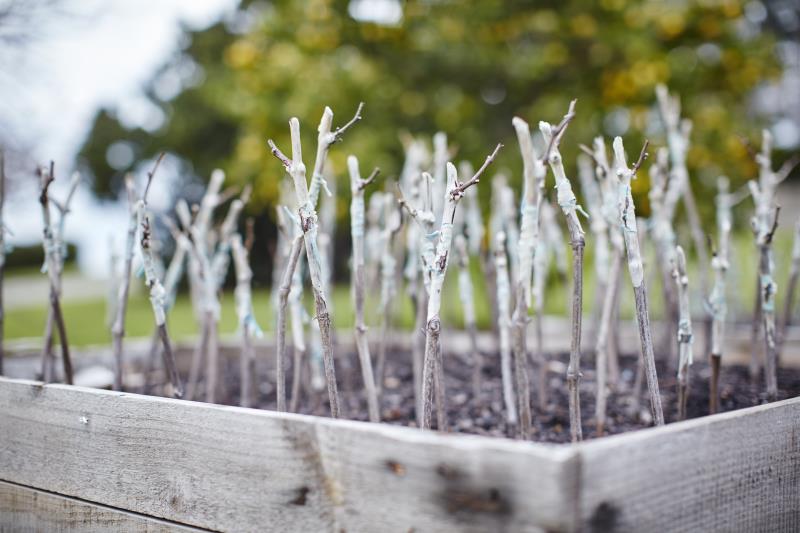
Vine cuttings. Photo credit: Ewen Bell Wine Australia
Pests and diseases
Australian grape producers face significant problems with grapevine trunk diseases such as eutypa dieback and botryosphaeria dieback (bot canker), which diminish yields and eventually kill the vines.
Powdery mildew, downy mildew and botrytis bunch rot are the top three disease concerns in Australian vineyards. Other disease include phomopsis, and viral diseases such as grapevine fleck, grapevine leafroll, Australian grapevine yellows and rugose wood.
The Australian authorities maintain very tight control over people and plants entering the country, with long quarantine periods for any imported vine cuttings, for instance. This is designed to prevent the arrival of new pests and diseases.
Yields
14.1 tonnes per hectare (2015)
Traditional wine pairings in the Victoria wine region
- Sparkling Shiraz is ideal for a barbecue on a hot, sunny day.
- With a mixed seafood salad, check out Sauvignon Blanc or Riesling, while Chardonnay will pair well with grilled fish or chicken.
- Pinot Noir is a food-friendly wine that can pair well with many dishes from pizza through to mushroom risotto.
- Try full-bodied fruity Shiraz with roast lamb or Cabernet Sauvignon with steak.
- Rutherglen Muscat is a perfect pairing with seriously wicked desserts like sticky toffee pudding or Christmas pudding.
Trade/commercial factors
Production area
23,087 ha
Number of producers
800 wineries
Annual production
319,471 tonnes of grapes (2015)
Interesting facts
In the 1880s Victoria was Australia’s largest wine-producing state with a thriving wine industry seeking to quench the thirst of miners during the gold rush in the vicinity of Rutherglen, Glenrowan and Heathcote.
Sources
All photos and maps are courtesy of Wine Australia
General statistics:
Australian Bureau of Statistics
[/mepr-show]

